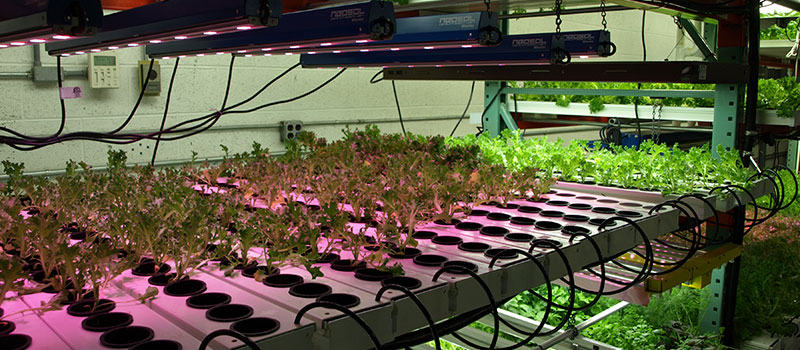CEA systems are engineered to provide optimal conditions for growing crops and to prevent disease and pest damage.
How it Works
Controlled-Environment Agriculture (CEA) is the practice of growing plants indoors using engineering, plant science, and computer-managed greenhouse control technologies to optimize plant growth, quality, and production efficiency. By controlling temperature, light, carbon dioxide, and the root-zone growing medium, CEA can result in healthy and year-round production of edible, ornamental, and high value plants. Growing crops indoors on vertical or horizontal racks also conserves land area and can result in higher crop yields when compared to outdoor farming practices. Growing consumer preferences for healthier and locally sourced foods, climate change, innovations in plant science, and dramatically reduced costs of LEDs for artificial light have also made it more economical to grow plants indoors. Micro greens, which are high value produce that requires sensitive handling and short shelf lives are good candidates for CEA facilities. 1
CEA farms are mainly located in buildings resembling warehouses, but other types of structures are used as well. Although CEA shares some of the characteristics of greenhouses, mushroom houses, and other indoor agricultural practices, they require different types of buildings, technologies, and workforce skills, such as software programming. CEA is also distinct from medical marijuana growing/processing. By including CEA and determining its fit in a municipal zoning ordinance, communities can help encourage and manage it as a component of its land use policies.
Indoor agricultural activities are not new to Chester County. Southern Chester County is currently the largest indoor agriculture center in the country. 2 Chester County produces over half of all mushrooms consumed in the United States and the County's agriculture industry contributes over $3 billion to the local economy through sales, employment, taxes, and services. 3
Benefits
Extended Growing Seasons
Controlled conditions allow growing a variety of crops to be harvested year-round regardless of the season.
Sustainable Development
CEA facilities can be located in repurposed warehouses, strip malls, and other types of large buildings.
Economic Opportunities
CEA can increase economic and employment opportunities, especially for start-up CEAs.
Locally Sourced Food
Locally sourced produce can reduce transportation costs and increase speed to markets.
Reduced Pesticide Use
Compared to conventional farming there is potential to use fewer pesticides due the enclosures of CEA facilities.
Less Nutrient Loss
The application of nutrients can be easily measured and monitored, resulting in more efficiency compared to conventional farming practices.
2 CCEDC (Chester County Economic Development Council)
AgConnect
3 Chester County Ag Council
Farming Facts
CEA activities can involve multi-level growing areas, so municipalities should consider maximum building heights.
Get Started
Municipalities should recognize that CEAs can be compatible with their commercial and industrial land use policies and can be appropriate in those districts. A first step is to define CEA as a type of valid land use in the zoning ordinance. A second step is to determine where CEA best fits in the community. CEA facilities require adequate water, sewer and electric utilities and good transportation access. Warehouse buildings and strip malls typically have good access to transportation, utilities, and workforce, and can be good candidates for future CEA facilities.
When CEAs are permitted in agricultural zoning districts, they should not be limited to agricultural zoning districts. Municipalities should also determine lot coverage limits and consider appropriate stormwater management for these activities.
Considerations
Building Height
CEA activities can involve multi-level growing areas, so municipalities should consider maximum building heights.
Water Usage
CEAs may require increased amounts of water from public sources. Municipalities can work with the Chester County Conservation District to encourage rainwater harvesting and the re-use of irrigation water.
Workforce Skills
An educated workforce familiar with automation and plant science is necessary.
Building Code Ambiguity
The International Construction Code, which is the model for the Pennsylvania Uniform Construction Code, is unclear regarding regulations that will apply to indoor agriculture. The municipal building official may need to exercise flexibility in reviewing CEA proposals.
Differences from Mushroom Houses
CEA facilities require artificial and natural lighting facilities that mushroom houses do not. Also, mushroom cultivation involves the use of composted horse manure and straw that is typically mixed into mushroom soils which need to be periodically removed from the mushroom house, which is generally not required by CEAs. Also, mushroom houses typically have one story building heights, while CEA facilities may involve multiple stories.
Potential Adverse Effects
- Nighttime operations using LEDs has the potential to disturb neighbors. Municipalities should control potential light trespass and "skyglow" from CEA activities.
- Landscape screening should be considered when CEAs are near residential areas.
- Outdoor stockpiling of materials, such as fertilizers, should be controlled to avoid stormwater contamination.

Kennett Township
The Kennett Township Zoning Ordinance defines Mushroom-related uses.

Valley Township
The Valley Townships Zoning Ordinance defines controlled environment agriculture (CEA) and provides specific criteria to the use.




